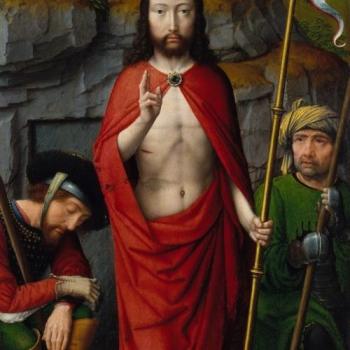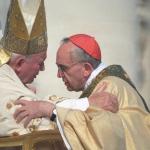Ever since the Risen Christ told the disciples on the Emmaus Road…
“These are my words which I spoke to you, while I was still with you, that everything written about me in the law of Moses and the prophets and the psalms must be fulfilled.” Then he opened their minds to understand the Scriptures, and said to them, “Thus it is written, that the Christ should suffer and on the third day rise from the dead, and that repentance and forgiveness of sins should be preached in his name to all nations, beginning from Jerusalem. You are witnesses of these things. And behold, I send the promise of my Father upon you; but stay in the city, until you are clothed with power from on high.” (Lk 24:44–49).
Christians have believed that, as Augustine said, the New Testament is hidden in the Old, and the Old Testament is only fully revealed in the New.
That’s why Jesus is constantly mining the Old Testament to show us signs pointing to himself: the Temple, the Passover, the manna in the wilderness, the Bronze Serpent and a whole lot more are declared by Jesus to be signs pointing to him.
So Paul will tell the Corinthians that the events recorded in the Old Testament “happened to them as a warning, but they were written down for our instruction, upon whom the end of the ages has come” (1 Co 10:11).
Likewise, the book of Revelation will say:
And I saw in the right hand of him who was seated on the throne a scroll†† written within and on the back, sealed with seven seals; and I saw a strong angel proclaiming with a loud voice, “Who is worthy to open the scroll and break its seals?” And no one in heaven or on earth or under the earth was able to open the scroll or to look into it, and I wept much that no one was found worthy to open the scroll or to look into it. Then one of the elders said to me, “Weep not; behold, the Lion of the tribe of Judah, the Root of David, has conquered, so that he can open the scroll and its seven seals.”
And between the throne and the four living creatures and among the elders, I saw a Lamb standing, as though it had been slain, with seven horns and with seven eyes,§§ which are the seven spirits of God sent out into all the earth; and he went and took the scroll from the right hand of him who was seated on the throne. And when he had taken the scroll, the four living creatures and the twenty-four elders fell down before the Lamb, each holding a harp, and with golden bowls full of incense, which are the prayers of the saints; and they sang a new song, saying,
“Worthy are you to take the scroll and to open its seals,
for you were slain and by your blood you ransomed men for God
from every tribe and tongue and people and nation,
and have made them a kingdom and priests to our God,
and they shall reign on earth.”Then I looked, and I heard around the throne and the living creatures and the elders the voice of many angels, numbering myriads of myriads and thousands of thousands, saying with a loud voice, “Worthy is the Lamb who was slain, to receive power and wealth and wisdom and might and honor and glory and blessing!” And I heard every creature in heaven and on earth and under the earth and in the sea, and all therein, saying, “To him who sits upon the throne and to the Lamb be blessing and honor and glory and might for ever and ever!” And the four living creatures said, “Amen!” and the elders fell down and worshiped. (Re 5:1–14).
In its own visionary, apocalypsey way, Revelation is making the same point as Jesus and Paul: the true meaning of the Old Testament is “sealed” and cannot by unsealed apart from Jesus, the Lion and Lamb who was slain–since his Spirit is the true author of the Scriptures. So Paul tells the Corinthians:
Since we have such a hope, we are very bold, not like Moses, who put a veil over his face so that the Israelites might not see the end of the fading splendor. But their minds were hardened; for to this day, when they read the old covenant, that same veil remains unlifted, because only through Christ is it taken away. Yes, to this day whenever Moses is read a veil lies over their minds; but when a man turns to the Lord the veil is removed. Now the Lord is the Spirit, and where the Spirit of the Lord is, there is freedom. And we all, with unveiled face, beholding the glory of the Lord, are being changed into his likeness from one degree of glory to another; for this comes from the Lord who is the Spirit. (2 Co 3:12–18).
This is why the Mass is structured as it is and why the Church did not follow the lead of Marcion by chucking out the Old Testament and replacing it with the New. Instead the Church retains the Old Testament as the “oracles of God” (Rom 3:2). She continues, in the Mass, to look for Christ hidden there. So when you listen to the reading, pay particular attention to the way in which the Old Testament and the Gospel readings are combines and you will often see the Lamb unsealing the meaning of the Old Testament in surprising ways.
I had that happen on Saturday night in a small way and it was very consoling. Let me share my little epiphany briefly.
First: the readings:
Old Testament
The LORD said to Moses and Aaron, “When a man has on the skin of his body a swelling or an eruption or a spot, and it turns into a leprous disease on the skin of his body, then he shall be brought to Aaron the priest or to one of his sons the priests, he is a leprous man, he is unclean; the priest must pronounce him unclean; his disease is on his head.
“The leper who has the disease shall wear torn clothes and let the hair of his head hang loose, and he shall cover his upper lip and cry, ‘Unclean, unclean.’ He shall remain unclean as long as he has the disease; he is unclean; he shall dwell alone in a habitation outside the camp. (Le 13:1–2, 44-46).
Gospel
And a leper came to him begging him, and kneeling said to him, “If you will, you can make me clean.” Moved with pity, he stretched out his hand and touched him, and said to him, “I will; be clean.” And immediately the leprosy left him, and he was made clean. And he sternly charged him, and sent him away at once, and said to him, “See that you say nothing to any one; but go, show yourself to the priest, and offer for your cleansing what Moses commanded, for a proof to the people.” But he went out and began to talk freely about it, and to spread the news, so that Jesus could no longer openly enter a town, but was out in the country; and people came to him from every quarter. (Mk 1:40–45).
There’s lots you can say about these passages. Leprosy, of course is an image of sin (which is why the Psalms are all about confession and purification. If you want to know more about that go here and here. And Jesus’ treatment of the leper is startling and counter-cultural. Even today, when we are supposedly free of “primitive Bronze Age taboos” (meaning “We like bacon”) you won’t find too many people eager to touch lepers or even somebody’s dandruff. But Jesus reaches out and touches the leper.
Another thing to note is that in doing so, Jesus turns the Old Testament prohibition into a sign of the New Covenant. The Old Covenant could not take away sin. So the solution the Pharisees struck on was separation (“Pharisee” means “separated one”). Living in a sinful world, they drew their skirts around them and avoided contact with ritual defilement. But Jesus comes into the world with a new power that overcomes sin and defilement. (If you want some interesting reading look at Matthew 8-10, right after Jesus, the New Moses, comes down from a New Mountain where he has promulgated the New Law of the New Covenant in the Sermon on the Mount. Matthew carefully strings together a whole series of encounters between Jesus and various people who are ritually defiling: a leper, a Gentile centurion, a woman with a hemorrhage, Levi the tax collector, a dead body. Yet in every encounter, Jesus is not defiled but instead power goes out from him to heal, convert, redeem, and even raise the dead. The same thing is on display in the reading from Mark.
But that’s not what struck me about the reading.
What struck me was this: In the OT, the leper is forced to live outside the camp, an exile from his own people: “he is unclean; he shall dwell alone in a habitation outside the camp”.
In the gospel, after the healing Jesus tells the leper to keep quiet about it. But instead the leper goes and blabs about it in the town. Result: “Jesus could no longer openly enter a town, but was out in the country”. Jesus, in short, does not merely heal the leper, he takes his place and become the exile himself.
I found that very consoling somehow, since (like anybody) I have days when I feel lonesome and exiled. The message of the gospel is “That’s where Jesus goes”. It’s also the message, by the way, of Pope Francis (and why modern Pharisees hate him too. He’s not afraid to touch lepers, go outside the false Fortress Katolicus that some have demanded we replace the Church with.
And for the final kicker, we see that as Jesus goes outside the camp and takes the place of the leper, something extraordinary happens. Just as with the reversals in Matthew 8-10, Jesus does not remain alone and exiled. Instead “people came to him from every quarter”. This has been the experience of the Church many times too. The monks rushed to the desert and the cities rushed out to join the monks. A Mother Teresa goes to lose herself among the poorest of the poor and the world seeks her out. Jesus, despised and rejected of men, draws all men to him.
Anyway, I just found that consoling when I was feeling blue on Saturday and thought I’d share it.















